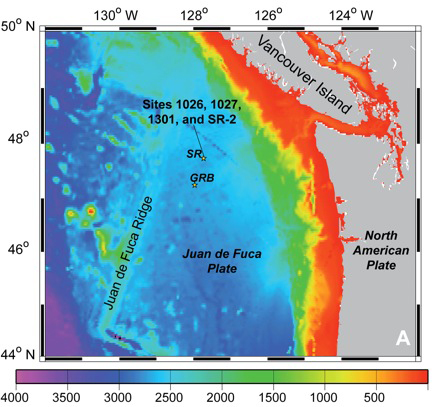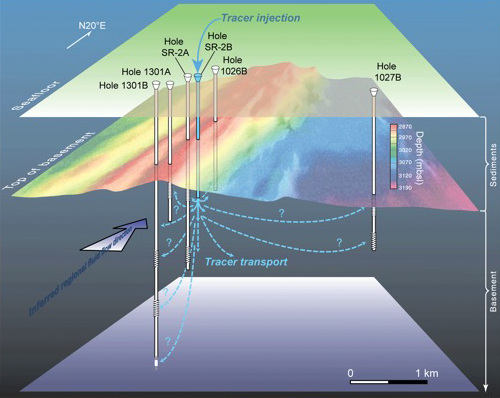A study based on the first cross-hole tracer experiment in the volcanic ocean crust was completed and submitted during the 2015 review period (Neira et al., 2015). This study tracked the injection and transport of a dissolved gas tracer (sulfur hexafluoride, SF6), using an array of CORKs instrumented with autonomous fluid samplers. All of the fluids used for this study were collected using wellhead samplers, 10 with tubes and fittings that connected the samplers to crustal intervals hundreds of meters below the seafloor. During the first three years after tracer injection, SF6 was transported both north and south through the crustal aquifer, with an observed tracer transport rate of ~2 m/day. This is orders of magnitude faster than inferred from either thermal and chemical observations and/or the results of coupled fluid-heat flow simulations (described above). Taken together, these results suggest that the effective porosity of the upper volcanic crust, the volumetric fraction of rock through which most lateral fluid flow occurs, is <<1%, with most of the fluid flowing rapidly along a few well-connected channels, and the rest of the crust being dominated by diffusive and reactive processes. This finding is consistent with the heterogeneous (layered, faulted, and/or fractured) nature of volcanic upper ocean crust, and will require careful representation of physical and geochemical characteristics in future reactive transport models (e.g., relatively low specific surface area for reaction, limited interaction between microbes and flowing fluids). Additional work is underway to analyze tracer concentrations in downhole samples recovered in Summer 2014 from four CORK systems (deJong et al., 2015). These samples provide critical information on tracer transport during the four years following tracer injection, including a time period that is not represented in the seafloor samples analyzed to date, prior to wellhead instrumentation of new CORKs installed on IODP Expedition 327.
Lin et al. (2015a) evaluated basement fluid samples collected from three CORKs in the JdF region, finding dissolved free amino acids (1–13 nM) and dissolved hydrolyzable amino acids (43–89 nM) in the volcanic upper crustal aquifer. The amino acid concentrations in the ridge-flank basement fluids are relatively low, but similar to those found in deep seawater. Potential sources of amino acids in the basement fluids include: amino acids in deep seawater that recharges the crustal hydrothermal system, in situ amino acid production, and diffusional input from overlying sediments. Thermodynamic modeling shows that amino acid synthesis in the basement can be sustained by energy supplied from inorganic substrates via chemolithotrophic metabolisms. Furthermore, an analysis of amino acid concentrations and compositions in basement fluids support the hypothesis that there is ongoing heterotrophic activity in this system. Similarly, the enrichment of acidic amino acids and depletion of hydrophobic ones relative to sedimentary particulate organic matter suggests that surface sorption and desorption alter amino acids in the basaltic basement. In summary, although the oceanic basement aquifer is a net sink for deep seawater DOC, similar amino acid concentrations in basement aquifer and deep seawater suggest that DOC is preferentially removed in the basement over dissolved amino acids. This study also suggests that organic carbon cycling occurs in the oceanic basaltic basement, where an active subsurface biosphere is likely responsible for amino acid synthesis and degradation.
Lin et al. (2015b) completed a study of dissolved and particulate organic matter in sediments overlying basement that is close to the Grizzly Bare outcrop, the primary site of hydrothermal recharge for this ridge flank. They found that sedimentary DOC increased from 0.25 mM at 1 m below the seawater sediment interface to a maximum of 0.86 mM at mid-depth (8–11 meters below seafloor [mbsf]), before subsequently decreasing to a minimum of 0.10 mM at the sediment/basement interface. Thus, the oceanic basement appears to be a net sink for sedimentary DOC in this location. This finding is complementary to work by Orcutt et al. (2015) and Lin et al. (2015a) indicating that microbial processes in the volcanic upper crust include significant oxygen removal. Sedimentary DOC and alkalinity profiles were similar, and inversely mirror those of sulfate, suggesting that the buildup of DOC in pore water in the middle of the column is related to remineralization of sedimentary POC.
A new study by Jungbluth et al. (2015, in press) represents a major advance in understanding how microbial communities in the upper ocean crust relate to those seen in overlying sediments and the ocean. In this study, the analysis of 1.7 million small subunit ribosomal RNA genes amplified and sequenced from marine sediment, bottom seawater, and basalt-hosted deep subseafloor fluids that span multiple years and locations on the Juan de Fuca Ridge flank was used to quantitatively delineate a subseafloor microbiome comprised of distinct Bacteria and Archaea. Hot, anoxic crustal fluids accessed with CORKs contained abundant bacterial lineages of phylogenetically unique Nitrospirae, Aminicenantes, Calescamantes, and Chloroflexi. While less abundant, the domain Archaea was dominated by unique, uncultivated archaeal lineages of marine benthic group E, the thermal hot spring crenarchaeotal group, the 11 Miscellaneous Crenarchaeotal Group, and relatives of cultivated, sulfate-reducing Archaeoglobi. Consistent with recent geochemical measurements and bioenergetic predictions, potential importance of methane cycling and sulfate reduction were imprinted within the basalt-hosted deep subseafloor crustal fluid microbial community. This unique window of access to the deep ocean subsurface basement reveals a microbial landscape that exhibits previously undetected spatial heterogeneity.
Ongoing studies have also explored the nature of viruses in the volcanic ocean crust (Nigro et al., 2015a, 2015b, Steward et al., 2015). While viruses undoubtedly affect the ecology of microbial communities inhabiting this high-pressure, extreme environment, their significance remains mostly unknown. Recent improvements in sampling infrastructure have allowed the processing of large volumes of crustal fluids (thousands of liters) retrieved from JdF CORKs. Analysis of TEM images revealed distinct viral morphologies (rod and spindle-shaped) that resemble the morphologies of viral families infecting archaea. There are very few, if any, direct observations of these viral morphologies in marine samples, although they have been observed in enrichment cultures and their signature genes detected in metagenomic studies from hydrothermal vents and marine sediments. Analysis of metagenomes from the JdF crustal fluids revealed sequences with homology to archaeal viruses from the rudiviridae, bicaudaviridae and fuselloviridae. Prokaryotic communities in fluids percolating through the basaltic basement rock of the JdF are distinct from those inhabiting the overlying sediments and seawater. Similarly, our data support the idea that the viral assemblage in these fluids is distinct from viral assemblages in other marine and terrestrial aquatic environments. This study also suggest that viruses contribute to the mortality of deep subsurface prokaryotes through cell lysis, and viruses may alter the genetic potential of their hosts through the processes of lysogenic conversion and horizontal gene transfer.
These biogeochemical and microbial studies could not have been completed without large volumes of pristine fluids from deep below the seafloor; this technical capability did not exist prior to CDEBI Phase 1. Developing and applying a series of linked tools that permit access to samples of this kind (clean CORK observatory sealing and sampling systems, long-term pumps with inline filters, autonomous instrumentation control, etc.) comprises a significant technical achievement. The studies described above, and additional work documented in the the 2015 C-DEBI Annual Report bibliography, shows the way forward into Phase 2 of C-DEBI. Thermal, tracer, and modeling studies help to address issues of importance to the Fluxes and Connectivity theme, and environmental, laboratory and theoretical studies are helping to resolve questions related to the microbial Activity and Communities theme and hypotheses involving the Metabolism and Survival theme. The nature of links between the JdF major program and Phase 2 research themes is especially apparent in synthesis studies, which have compared and contrasted JdF results to those achieved with samples and data from other settings (e.g., Lever et al., 2015; Orcutt et al., 2015).
C-DEBI Juan de Fuca Ridge Flank Expedition History
UNOLS Expedition, June 15 – July 1, 2010
Microbial ecology of ocean basement aquifers: ODP borehole observatories
Chief scientist: Jim Cowen
[UNOLS Expedition website]
IODP Expedition 327, July 5 – September 5, 2010
The hydrogeologic architecture of basaltic ocean crust: compartmentalization, anisotropy, microbiology, and crustal-scale properties on the eastern flank of Juan de Fuca Ridge, eastern Pacific Ocean
Co-chief scientists: Andy Fisher and Takeshi Tsuji
[IODP Expedition 327 Proceedings] [JOIDES Resolution Expedition 327 Outreach]
UNOLS Expedition, June 28 – July 14, 2011
AT18-07 RV Atlantis/ROV Jason-II: Eastern flank of the Juan de Fuca Ridge CORK dive program
Co-chief scientists: Andy Fisher, Jim Cowen and Keir Becker
[Preliminary Cruise Report PDF, 26 MB] [JOIDES Resolution AT18-07 Outreach]
UNOLS EXPEDITION, July 13-26, 2013
AT 26-03 RV Atlantis/ROV Jason II: Hydrogeologic, geochemical, and microbiological experiments in young ocean crust of the northeastern Pacific Ocean using subseafloor observatories
Chief scientist: Andy Fisher
[Preliminary Cruise Report PDF, 11 MB] [UNOLS-JASON Expedition website]
UNOLS EXPEDITION, August 10-24, 2014
AT 26-18 RV Atlantis/ROV Alvin: Completing single- and cross-hole hydrogeologic and microbial experiments: Juan de Fuca Flank
Chief scientist: Geoff Wheat
[Preliminary Cruise Report PDF, 2 MB] [UNOLS-JASON Expedition website]



